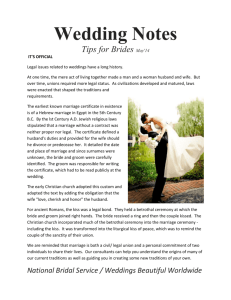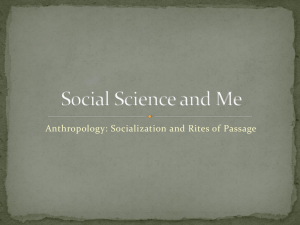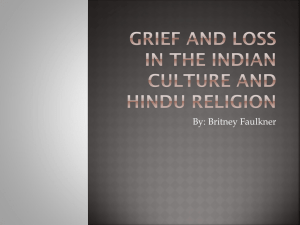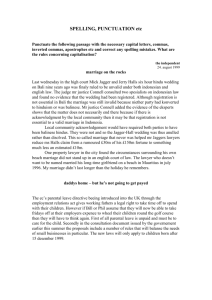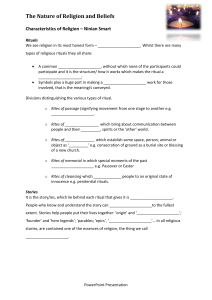Circleoflife1 - University of Kentucky
advertisement
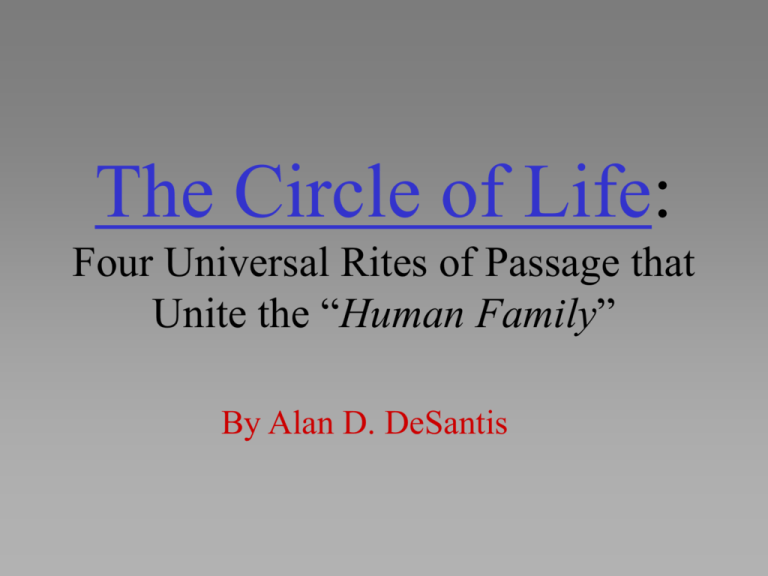
The Circle of Life: Four Universal Rites of Passage that Unite the “Human Family” By Alan D. DeSantis The Circle of Life • 1) On the surface, our world and its people seem very different (if not outright strange) – Different foods, languages, Gods, clothes, etc. • 2) Below the surface, however, societies share many commonalities that, at first glance, are not apparent – Philosophers call these “Cultural Structures” • 3) One of the most fascinating commonality is the Four Universal Rites of Passage that Unite the “Human Family” Four Universal Rites of Passage • Every culture celebrates . . . – 1) Birth • We enter life – 2) Coming of age • We enter into adulthood – 3) Marriage • We enter life with a partner – 4) Death • We enter the afterlife with the belief that we will be re-born • In essence, every culture believes that we all symbolically die and are spiritually re-born many times Birth Birth and Childhood • Ever society has a ritual to welcome children into the world and integrate them into the community • “When a child is born, they have only a physical existence; they are not yet recognized by their family nor accepted by the community. It is only by virtue of those rites performed immediately after birth that they are incorporated into the community of the living.” – -Mircea Eliade (The Sacred and the Profane) Burgos, Northern Spain Ekundu-Kundu in Cameroon Palau, Micronesia Yemen Northern Australian Aboriginals St. Theresa’s Catholic Church in DC • “Every church still has its baptismal font in which initiates are bathed or symbolically drowned. After a figurative death in the baptismal bath, they come out transformed as reborn ones.” – C. G. Jung (Symbolic Life) Coming of Age (Passage into Adulthood) Coming of Age • To become fulfilled members of their society, adolescents must understand when 1) childhood ends, 2) adulthood begins, and 3) what their culture expects of them • Girls: In parts of Africa, South America, and various Native American communities, when girls begin menstruating, they are secluded and taught the art of womanhood by the older females in their community Coming of Age • Boys: typically face an ordeal or trial where they earn and affirm their passage to manhood. – This can range from first hunts & ritual warfare • What ever the case, both sexes understand that the ordeal will officially mark their entrance into adulthood – They never think of themselves as children again Congolese Kota Boys Apache Girl The song chanted by all members of the Apache Tribe • “Now you are entering the world. • You become an adult with responsibilities . . . • Walk with honor and dignity . . . • For you will become the mother of a nation.” Lesse girl, Zaire, Africa Seclusion and Womanhood • From the Zulus of South Africa to the Cuna of South America, seclusion is an almost universal response to the onset of menstruation in non-industrial societies. The menstruation hut is seen as a safe place where a girl may complete her physical transformation to womanhood while learning her adult responsibilities. A girl in Cairo is circumcised Kingston, Jamaica The use of “substances” in rituals • The use of incense, hallucinogens, or alcohol to alter the senses is a common initiatory practice worldwide. • In our culture, we will often . . . – 1) Smoke cigars at the birth of a child – 2) Toast champagne at weddings – 3) Take wine at Christian communions – 4) Do shots on our 21st Birthday • A rite of passage (close to death) Quite Forest in Italy Yoda Pecos River, Texas The Importance of Hunting Around the World • While hunting is no longer a vital skill in most of the world, many people in traditional societies still consider the first hunt to be a necessary milestone on the road to adulthood. – 1) Among the Kung in Namibia, a boy traditionally cannot marry until he has made a kill – 2) Among the Yupik of Alaska, a passage to manhood occurs when a boy kills his first seal Dani tribesmen of Indonesia Like American football, such games provide a more harmless outlet for the warrior energy Rio de Janeiro, Brazil Vanuatu Jumpers • “Boys everywhere have a need for rituals marking their passage to manhood. If society does not provide them, they will inevitably invent their own.” –Joseph Campbell This is one explanation for the extreme popularity of Fraternities throughout America East Los Angeles • “Trials of strength and endurance are common to all initiations. The adult must be brave in the face of danger and must be steadfast in the face of pain.” • Professor J. A. Jackson Maasai woman in Kenya American adolescents also ritualistically mark their bodies. Is this to become part of, or separate from, the community? Coming of Age • Western cultures have largely abandoned the initiation rites that honor the adolescent transition • “Modern society has provided adolescents with NO rituals by which they become members of the tribe, of the community. All children need to be twice born, to learn to function rationally in the present world, leaving childhood behind.”--Joseph Campbell • Consequently, we have too many men and women in “arrested development”—not becoming adults, acting like irresponsible children well into their 30s Dallas, Texas Prom Night--Louisville, Kentucky Prom Night—Papue New Guinea • “Comparison of rites from all over the world suggest that these initiation rites themselves possess an archetypal structure, for the same underlying patterns and procedures are universally apparent.” • Anthony Stevens Marriage Marriage • For most of humanity’s history, marriage was more an alliance between families than a bonding to two individuals in love • Marriages were formed to reinforce kinship lines or improve the social or economic status of the families involved • Starting in Europe in the 12th Century, a new impulse began to take hold—Romantic Love – Marriage became about personal happiness • Today, our marriages join love, happiness, sex, procreation, finance, & family ties into one relationship – Without a doubt, the most complicated of all relationships – No wonder 51% of all marriages end in divorce – Are we asking too much from this one relationship? A Berber girl in Morocco (and the legend of Isli & Tilsit) Kyoto, Japan Marriage Question #1 • Question: Why are bridesmaids all dressed a like? • Answer: Roman law required ten witnesses to make a wedding legal. Several of these witnesses dressed up exactly like the bride and groom to confound any evil forces who might show up uninvited. • *There is no answer, however, why bridesmaids dresses are always ugly Sydney, Australia Marriage Question #2 • Question: Why is the ring placed on the third finger on the left hand? • Answer: The ancient Greeks believed that a vein in this finger ran directly to the heart. • *Note: Because of an advertising campaign by the diamond industry in the 20th Century, we now all think it is customary to give diamond rings for engagements. Lendak, Czechoslovakia Marriage Question #3 • Question: Why does the bride stand to the left and the groom to the right? • Answer: Ex-suitors, romantic lunatics, and other thugs sometimes rushed the alter to take the bride. Thus, the groom needed to keep his right hand free so he could grab his sword. • *Lesson: Always steal the bribe of a left handed groom! Louisville, Kentucky Marriage Question #4 • Question: Where did the term Honeymoon come from? • Answer: 4,000 years ago in Babylon, it was customary for the bride's father to provide his new son-in-law with mead (beer made from honey) for one lunar cycle (or one month). “Honey month” became “Honeymoon.” • *Note: Walt Disney World is the #1 site in America for Honeymooning (replacing Niagara Falls) U.S. Naval Academy, Annapolis, Maryland Northeastern Romania Marriage Question #5 • Question: How much money does the average American wedding cost (clothes, food, drink, etc.) ? • Answer: $21,000 Morocco Wedding Nights Around the World • 1) Among the Hausa of Nigeria, for example, grooms bring their brides gifts such as perfume and blouses to persuade them to be romantic • 2) In Taiwan, a marriage is consummated on the wedding night, but only after the bride and groom are teased for a considerable amount of time • 3) In Zambia, a bride walks backwards into her husband’s house and is escorted to her wedding bed by an older woman who has acted as her sex and marriage instructor. She presents her husband with fertility beads, each representing a future child. • “Every culture has a wedding ceremony that serves as a rite of passage for the two young participants. It marks the end of who they were and the beginning of who they will become.” • Marion Woodman Death Death • When a loved one dies, we go through a gamut of emotions – Denial, bargaining, anger, depression, & acceptance (5 stages) • To help us deal with this pain—and to help us face our own mortality—societies throughout the world have created a diverse set of rituals – These rites all honor the deceased and consecrate their passage to the next world • Unlike most Eastern and non-industrial societies, modern Western cultures (including USA) seem to resist and insulate the reality of death – Don’t talk about it; If you do, you are morbid and depressing • “Death is the key to the door of life. It is through accepting the finiteness of our individual existences that we are enabled to devote each day of our lives—however long they may be—to growing as fully as we are able.” – Elisabeth Kubler-Ross Taoist Funeral, China Transylvania, Romania A Christian cemetery in Colma, California Understanding our Rituals • 1) Mourning clothing: Pagans dressed in different (special) clothes so that the evil spirits would not recognize them. • 2) Covering the face: Once believed that the dead’s spirit would escape through the mouth & nose • 3) The firing of gun shots (21-guns): Once spears were thrown in the air to try to hit the evil spirits covering of the dead’s grave • 4) Why flowers: Floral offerings were originally intended to gain favor with the spirit of the deceased The First Act of Humans • Traces of pollen discovered in burial caves in northern Iraq indicate that Neanderthal communities put flowers on the graves of their dead. So with bouquets of flowers or gravestones of marble, humankind has been marking the final resting places of loved ones for at least 60,000 years. Soviet Moldavia Leatherwood, Kentucky • “Family and community involvement in death & dying rituals [like that found in Leatherwood] give individuals the comfort of shared responsibility and shared mourning. It helps all involved to view death as a part of life.” – Kubler-Ross Dani people of Irian Jaya Some (less-than-poetic) Death Rituals • 1) Some cultures burn the body out of fear • 2) Some simply run away from the dead, leaving them to rot • 3) Zoroastrians left their dead to be devoured by vultures. To bury it would be a defilement to mother earth • 4) In Tibet, dogs are used for this purpose, believing that those eaten by dogs will be better off in the other world • 5) Many African tribes still grind the bones of their dead and mingle them with food to be eaten New Orleans, LA Find picture Indian Funeral Pyre Bathurst Island, of the coast of Northern Australia • “Do not go gentle into the good night, Rage, rage against the dying of the light.” –Dylan Thomas » (writing of his father’s death) A Baimi tribesman of Papua New Guinea Concluding Thoughts • The importance of this finding – 1) We find that there are 4 universal rites & rituals that all cultures enact —regardless of race, religion, & ethnicity – 2) We find that these universal rites & rituals supply each culture with meaning and significant to their lives – 3) We find that at a deeper cultural level, we are a lot more alike than we are different The End

